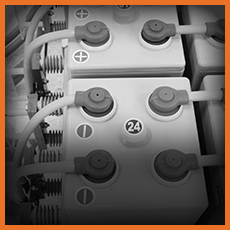OVERVIEW
As electricity use rises and falls over the course of a day, grid operators must nimbly balance electricity supply and demand so the two remain instantaneously matched.1 Energy storage facilitates this balance by engaging a range of technologies2 that store energy until it is needed, whether that is a second, minute, or day later. By doing so, energy storage can alleviate intermittency (those moments when the wind doesn’t blow or sun doesn’t shine). This lets solar and wind more effectively fulfill base load electricity demands.3 This reduces the need for coal- and gas-fired plants to fill in the gaps when solar and wind is unavailable, reducing emissions. In addition, when energy storage helps avoid citywide blackouts or supplies power to military bases, our energy system becomes more reliable and secure. Energy storage can also improve electricity quality and prevent flickering lights. Finally, deploying energy storage for power reliability, security, and quality will displace many inefficient peaking plants, avoiding the emissions these seldom used plants produce.
ANALYSIS
Energy storage faces three major challenges. First, energy storage installations are expensive. Second, the regulatory system is not designed to accommodate energy storage installations. Third, regulatory gaps help create a market failure because businesses either do not know how to or may not be inclined to fully value energy storage.
Energy storage installations face high upfront costs: batteries and other novel technology materials are expensive4 Until costs go down, this means the revenue made by storing electricity at times of low demand and pricing and selling at times of high demand and pricing does not compensate the cost of technology. Of course, energy storage applications can also earn money by improving power reliability or power quality or deferring transmission investments. Nevertheless, any given benefit energy storage provides usually cannot provide sufficient return on investment to justify costs.5 Hoping to lower future costs, a variety of federal agencies support initiatives to promote energy storage R&D, focused on basic research,6 technology commercialization,7 and pilot project demonstrations.8
Regulation also remains a major challenge. Many energy storage technologies could be used for multiple applications,9 yet the regulatory structures that would allow utilities to recoup costs by doing so are underdeveloped.10 Although the Federal Energy Regulatory Commission (FERC) has made big strides towards commercializing energy storage for a few specific purposes,11 regulations have not caught up with potential market opportunities.
Because the regulations specifying how energy storage may charge for services are underdeveloped, investors are slow to consider energy storage technologies. While the U.S. does have enough large-scale pumped hydro capacity to power about 1.7 million homes,12 most new projects rely on batteries and other emerging technologies. Emerging technologies generally lack data on performance and reliability.13 In addition, power system planning models undervalue or exclude energy storage.14 When coupled with regulatory uncertainty, this means business largely cannot effectively estimate the potential value energy storage investments could bring, and is consequentially wary of investing in energy storage.
Outside of the grid-scale applications discussed above, distributed energy storage has the potential to save money for businesses and homeowners under an appropriate regulatory framework. Should it become available over the long term, cheap, and standardized energy storage can provide backup power to the data centers, banks, hospitals, and other institutions that must access it.
IMPLEMENTATION
Energy storage has benefitted from federal research, development and deployment. Now, energy storage will benefit from policies that remove regulatory barriers preventing faster market adoption.

